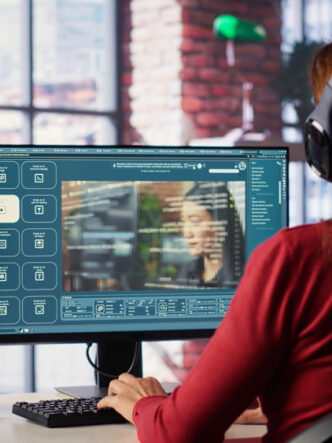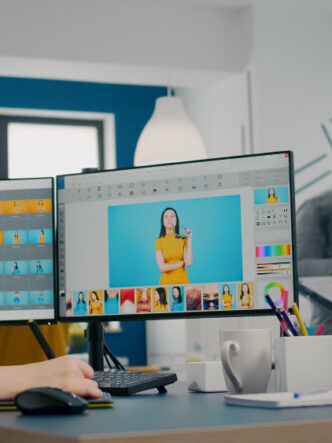Traditional corporate training methods are inadequate today when the attention spans of employees are shorter than ever. Ever-present distractions make it difficult for them to focus on lengthy training sessions. Their full schedules don’t offer much time for learning. In this type of environment microlearning video training is ideal. It breaks information down into short videos that are easier to digest and always available.

The power of video for retention and engagement
Recent research shows that almost 70% of learners prefer to use their mobile phones for learning. It makes sense to use videos as they work so effectively on mobile phones. Employees are already accustomed to using their mobile phones to watch videos so it’s a natural progression to watching corporate training videos.
Video-based corporate training is quick to create and easy to update. As the videos are short and cover a single topic, employees can easily retain and apply the knowledge in their daily work. Videos enable L&D teams to create narratives that engage employees because they can relate to them. This results in higher productivity and more return on investment (ROI).
Employees with access to a video library of training materials can watch training videos at any time and go at their own pace. Microlearning videos are part of a longer learning path. Learners can revisit material that’s more complex to understand and access further videos to reinforce their knowledge.
Tracking of employee progress is easy with microlearning. Corporate trainers can see where employees have gaps in their knowledge. They can offer them supplementary material and guidance to help fill these gaps.
Using the right video hosting platform enables corporate trainers to organize their video libraries in ways that make access easy. For example, they can create channels to house videos. This means employees can find what they need when they need it. They are never short of videos they can access to teach them new skills or give them more knowledge. As they are available in the workflow, employees can access them at a moment of need and apply the information.
Types of microlearning videos
Employee microlearning videos can come in different forms to suit varying purposes.
Short video tutorials
A classic format for video-based corporate training is the short video tutorial that teaches employees how to perform a specific task or process. A screencast video works well in the context of teaching employees how to use new software or tools. They have access to step-by-step instructions that they can put into practice while watching the video.
Explainer videos
An explainer video can make a difficult topic easier to understand. For example, a sales expert can clearly explain the benefits of a best-selling product to a newly hired sales executive.
Short animated videos
A short animated video with good graphics and a strong storyline provides a great way to train new recruits.
Scenario-based videos
Scenario-based videos can expose employees to the types of situations they will face in the workplace. These videos are particularly useful for training employees in high-risk jobs. When they have to make decisions in branching videos, they can see the consequences without the risks of being in a real-life situation.
Quizzes
Quizzes test employee knowledge through means such as multiple-choice or true/false questions. These quizzes reinforce key concepts. Employees can gauge how much they understand and see where they have gaps in knowledge. They can receive guidance when answers are wrong and encouragement when they are correct.
Tip videos
A short video embedded in an email can offer employees a tip of the day related to the industry, products, or their specific roles.
Summary videos
Corporate trainers can use a short video to summarize what employees learn in a full course that consists of short-form videos.
The Cincopa video hosting platform helps corporate trainers to create different types of employee microlearning videos. They can make them interactive with features such as quizzes, polls, annotations, and calls to action. There are also many customization features that can make corporate training directly relevant to employees and make training more cohesive.

Best microlearning video practices
Clearly defining learning objectives, choosing appropriate formats, and delivering short, relevant content are just a few of the best microlearning video practices.
1. Focus on a single learning objective
Corporate trainers shouldn’t try to cover too much in one video but rather focus on a single learning objective. This prevents any confusion and improves engagement in the learning process.
2. Get straight to the point
Employees respond more to content that’s relevant to them and with short videos it’s important to get straight to the point. Tell them what they can learn from the video and how it will help them right at the start.
3. Use interactive elements
When videos are interactive, they encourage employees to really get to grips with the content rather than just watching it passively. They may have to click for more information, answer questions, or fill in forms.
4. Provide captions and transcripts
Providing captions and transcripts for microlearning videos ensures they are accessible to a broader audience base, including those with hearing impairments. It also ensures that employees from different cultures who speak foreign languages can access content.
5. Personalize learning
L&D teams can make training content more relevant to employees by addressing their specific roles or needs within the company. This type of personalization increases engagement and retention of information.
6. Implement social learning
Corporate trainers should make use of chat rooms, discussion forums, etc. to enable social interaction and collaboration. When live streaming short-form learning videos, they can have Q&A sessions where they answer questions.
7. Regularly assess and improve microlearning videos
Through various feedback mechanisms like assessments, trainers can gauge the effectiveness of their short-form training videos. Advanced analytics provide them with in-depth insights into employee behavior while watching videos. For example, they may realize a video is too long or not engaging enough because completion rates are low.
Tools and platforms for delivery
Corporate trainers need to plan their delivery methods. They may deliver them through a Learning Management System (LMS), a mobile app, or use other methods. A wide range of tools are available today for making microlearning videos.
Video messaging is a useful tool for sharing personalized video messages with employees. Recording personalized messages with the camera on helps to create strong connections as employees see a human face. Cincopa has a video messaging screen recorder extension to use for this purpose. It’s simple to add annotations and share the recordings via email or embed them on a dedicated landing page on the company website.
Using Cincopa’s video hosting platform simplifies the delivery of all microlearning videos. Responsive design means they automatically adjust to fit the screen sizes and orientation of the mobile devices that many employees use for learning. They can use searchable tags to find specific content and even go to a specific chapter in a video rather than watching a whole video to find what they need. Cincopa’s advanced analytics also help with gaining insights to help improve microlearning videos.
Conclusion
When employees look forward to training, it becomes far more effective. As the workplace keeps evolving, microlearning can equip employees with the skills and knowledge they need to excel. The best workplace learning videos are short ones that offer fast and flexible training. A spaced repetition technique helps to reinforce learning over time. It builds knowledge step by step so it isn’t quickly forgotten.
Corporate trainers can see how effective microlearning video training is when it offers results such as faster delivery of projects. On the Cincopa home page, they can sign up for a free trial and explore how the platform can help them to create, manage, and deliver short-form learning videos.








